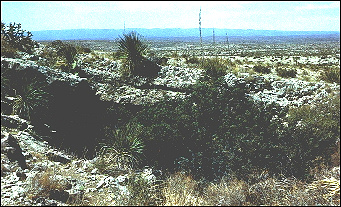

The common perception of deserts is one of desolation, but they are home to an amazing array of life that has evolved to survive under extreme conditions. What is a desert? Typically, annual precipitation is less than 10 inches and more water evaporates than falls during the year. The resulting dry conditions define deserts.
Within North America, there are four main deserts. The Great Basin is
the most northerly. Most moisture comes as winter snows. Characteristic plants include
sagebrushes, saltbushes, and grasses. The Mojave Desert with its winter rains lies
farther south, complete with its Joshua Tree and Blue and Mojave yuccas. The Sonoran
and Chihuahuan deserts lie mostly in Mexico and the southwestern United States.
Moisture in the Sonoran Desert comes twice during the year as winter and summer rains.
The Saguaro cactus is most often associated with this desert, with paloverdes and
ironwood being other indicator plants. In the Chihuahuan Desert, precipitation is
heaviest during the summer monsoons. The plants most indicative of this desert are
lechuguilla, tarbush, and sotols.

Listen to the Audio (mp3 format) as recorded by KTEP, Public Radio for the Southwest.
Contributor: Scott M. Cutler, Centennial Museum, University of Texas at El Paso.
Desert Diary is a joint production of the Centennial Museum and KTEP National Public Radio at the University of Texas at El Paso.

Upper-elevation Chihuahuan Desert in limestone country west of Carlsbad, New Mexico, with the Guadalupe Mountains in the distance. Photograph by A.H. Harris.